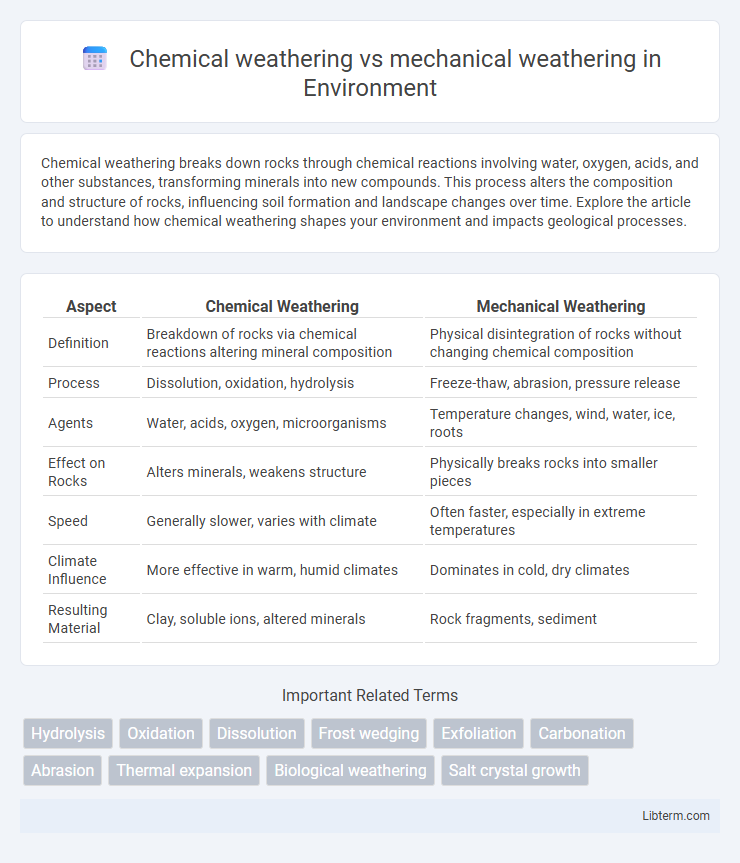Chemical weathering breaks down rocks through chemical reactions involving water, oxygen, acids, and other substances, transforming minerals into new compounds. This process alters the composition and structure of rocks, influencing soil formation and landscape changes over time. Explore the article to understand how chemical weathering shapes your environment and impacts geological processes.
Table of Comparison
| Aspect | Chemical Weathering | Mechanical Weathering |
|---|---|---|
| Definition | Breakdown of rocks via chemical reactions altering mineral composition | Physical disintegration of rocks without changing chemical composition |
| Process | Dissolution, oxidation, hydrolysis | Freeze-thaw, abrasion, pressure release |
| Agents | Water, acids, oxygen, microorganisms | Temperature changes, wind, water, ice, roots |
| Effect on Rocks | Alters minerals, weakens structure | Physically breaks rocks into smaller pieces |
| Speed | Generally slower, varies with climate | Often faster, especially in extreme temperatures |
| Climate Influence | More effective in warm, humid climates | Dominates in cold, dry climates |
| Resulting Material | Clay, soluble ions, altered minerals | Rock fragments, sediment |
Introduction to Weathering Processes
Chemical weathering involves the breakdown of rocks through chemical reactions such as hydrolysis, oxidation, and dissolution, altering the mineral composition and structure. Mechanical weathering physically disintegrates rocks into smaller fragments without changing their chemical composition, primarily through processes like freeze-thaw cycles, abrasion, and exfoliation. Both weathering types are essential in shaping Earth's surface, facilitating soil formation, and influencing landscape evolution over time.
Defining Chemical Weathering
Chemical weathering refers to the process of breaking down rocks through chemical reactions that alter the mineral composition, often involving water, acids, and oxygen. This type of weathering transforms original minerals into new substances, such as the conversion of feldspar into clay minerals. Unlike mechanical weathering, which physically fragments rocks without changing their chemical makeup, chemical weathering leads to the decomposition and dissolution of rock materials at the molecular level.
Defining Mechanical Weathering
Mechanical weathering involves the physical breakdown of rocks into smaller fragments without altering their chemical composition, driven by processes like freeze-thaw cycles, abrasion, and thermal expansion. This type of weathering contrasts with chemical weathering, which entails the chemical alteration or dissolution of minerals within rocks caused by reactions with water, oxygen, acids, and other agents. Understanding mechanical weathering is essential for studying soil formation, landscape evolution, and sediment production in various climatic and environmental conditions.
Key Differences Between Chemical and Mechanical Weathering
Chemical weathering alters the mineral composition of rocks through reactions with water, oxygen, acids, or other chemicals, leading to rock decomposition and soil formation. Mechanical weathering physically breaks rocks into smaller pieces without changing their chemical structure, primarily through processes like freeze-thaw cycles, abrasion, and root expansion. The key differences lie in chemical weathering's alteration of rock chemistry, contrasted with mechanical weathering's physical fragmentation.
Common Types of Chemical Weathering
Common types of chemical weathering include hydrolysis, oxidation, and carbonation, which break down minerals through chemical reactions with water, oxygen, and carbon dioxide. Hydrolysis alters feldspar into clay minerals, significantly changing rock composition, while oxidation causes rusting in iron-rich rocks, giving them a reddish color. Carbonation involves the reaction of carbonic acid with minerals like calcite in limestone, leading to dissolution and the formation of karst landscapes.
Examples of Mechanical Weathering
Mechanical weathering includes processes such as freeze-thaw cycles, where water expands upon freezing, causing rock to crack; abrasion, which occurs when particles scraped against rock surfaces wear them down; and biological activity, exemplified by tree roots growing into cracks and splitting rocks apart. Exfoliation, another example, involves the peeling away of outer rock layers due to pressure release. These processes physically break rocks into smaller fragments without changing their chemical composition.
Factors Influencing Each Weathering Type
Chemical weathering is influenced primarily by factors such as temperature, moisture, and the presence of acidic conditions, which promote reactions like hydrolysis, oxidation, and carbonation that alter mineral composition. Mechanical weathering depends largely on physical forces including freeze-thaw cycles, thermal expansion, and biological activity that cause rock disintegration without changing its chemical structure. Rock type and surface area availability also play critical roles in determining the rate and extent of both chemical and mechanical weathering processes.
Environmental Impact of Weathering Processes
Chemical weathering alters the mineral composition of rocks, releasing essential nutrients like calcium and magnesium into the soil, which supports plant growth and influences carbon cycling through the breakdown of carbonates and silicates. Mechanical weathering physically breaks down rocks into smaller fragments, increasing surface area and accelerating chemical weathering, while also contributing to sediment formation and landscape changes that affect habitats and water runoff patterns. Both weathering types play crucial roles in soil development, ecosystem sustainability, and regulating atmospheric CO2 levels by controlling the rate at which carbon is stored or released from rocks.
The Role of Weathering in Soil Formation
Chemical weathering alters the mineral composition of rocks through processes like hydrolysis and oxidation, enriching soil with essential nutrients such as calcium, potassium, and magnesium. Mechanical weathering breaks down rocks into smaller particles without changing their chemical structure, increasing the surface area for chemical reactions and accelerating soil formation. Together, these weathering processes create the mineral framework and texture of soil, influencing its fertility and ability to support plant life.
Conclusion: Comparing Chemical and Mechanical Weathering
Chemical weathering alters rock composition through processes like oxidation and hydrolysis, while mechanical weathering physically breaks rocks into smaller pieces without changing their chemical structure. Chemical weathering occurs more rapidly in warm, humid climates, whereas mechanical weathering dominates in cold or dry environments. Understanding the balance between these weathering types is crucial for predicting soil formation and landscape evolution.
Chemical weathering Infographic

 libterm.com
libterm.com